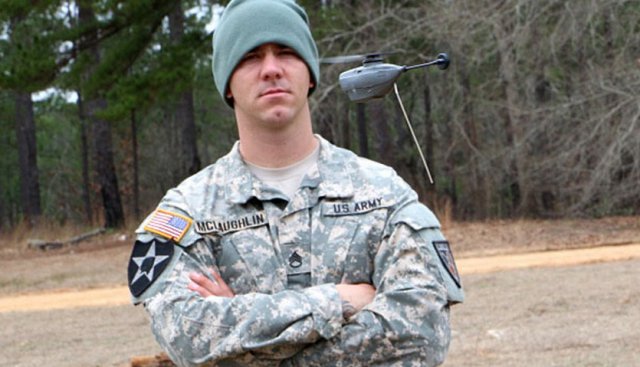U.S. Army manoeuvre officials here just finished testing miniature drones and other high-tech soldier kit at Fort Benning, much of which is designed to help infantry squads and platoons spot the enemy first.
From March 2 through March 5, soldiers from the Army’s Experimentation Force, or EXFOR, participated in the Army Expeditionary Warrior Experiment, an annual event aimed at evaluating innovative equipment with the potential to revolutionize infantry combat.
This year, the AEWE focused on 75 prototype technologies ranging from network communications gear to loadbearing kit, to sustainment and force protection equipment.
Many showed promise, but it was the pocket-sized Black Hornet and backpack-sized InstantEye unmanned aerial systems that captured the imaginations of 1st Platoon, A Company, 1st Battalion, 29th Infantry Regiment, the unit that makes up the EXFOR.
Hosted by the Maneuver Center of Excellence, the AEWE puts untested gear into the hands of infantrymen for a short period of intense field exercises. The experiment puts the EXFOR through a series of day and night missions and several fragmentary orders, or FRAGOs, to make test conditions as challenging as possible.
Despite all the impressive technology, none of it can attack and seize an objective and defend it against an enemy counterattack. The EXFOR platoon still had to adapt to imperfect orders, like the planned March 4 night attack that turned into a daylight mission to seize what was likely a battalion-size objective at the Selby MOUT Site here.
Soldiers then tell AEWE officials from Benning’s Maneuver Battle Lab how the gear performed and how it could be improved.
To Private First Class Logan Mims, the Black Hornet PD-100 Personal Recon System is something that every squad needs.
“It’s an incredible piece of machinery,” said Mims, who carried the nano UAS, made by Prox Dymanics USA Inc., in a special case attached to the side of his Improved Outer Tactical Vest.
The PD-100 is practically silent and resembles a tiny helicopter when it’s hovering near its target. It has an onboard camera that takes video and extremely clear pictures. It averages about 20 minutes of flight time.
It’s great for flying into an urban setting, Mims said, describing how it can hover outside of a window and take pictures of a potential enemy inside.
Spc. Erin Broihier was also impressed by the PD-100’s performance.
“I’ve never even thought of having a UAS as small as the Black Hornet,” the 26-year-old radio operator for A company said. “That thing is sick; I love it.”
The InstantEye Mk-2 Gen 3 small UAS also earned high marks because it would give platoons their own intelligence, reconnaissance and surveillance capability instead of having to rely on the company-level Raven UAS.
“It’s an ideal platoon UAS,” said Staff Sgt. Andrew Smith, 1st Platoon’s 1st squad leader.
Made by Physical Sciences Inc. /Tactical Robotics Group, the four-propeller, vertical takeoff and landing system is popular with the special operations community. It can fly at speeds up to 35 miles per hour out to about 1,000 meters and can provide real-time video and thermal imaging of an objective for 20 to 30 minutes.
“If I don’t know where a door is, one of these systems can find that door,” Smith said. “And sometimes it’s really nice to know what is on the other side of that hill. … It is, in my opinion, field ready.”
Source: Military.com

